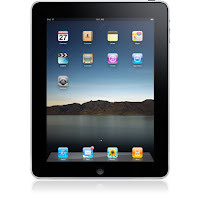The long-rumored Apple tablet has been released.
A 9.7 inches LED Multi-touch screen (1024x768 pixel with 132 ppi) with 1.5 pounds and 0.5 inch thin body, and 10 hours battery life.
It has a custom 1 GHz processor designed by Apple, Wi-Fi 802.11n connectivity, optional 3G modem, built-in speaker; and 16GB, 32GB, or 64GB of flash storage.
The iPad uses the same OS as the iPhone but with higher resolution, it means that iPhone Apps are supported.
Many great accessories specifically designed for iPad will be available.
Anything I can find I'll try to blog about it, be it GIS, mapping, programming, graphics, CAD, networking, gadgets, music, both in English and Arabic. Technically everything tech-related and tech-unrelated.
2010-01-29
2010-01-28
Oracle Sun Acquisition complete
Earlier today, Oracle held an event to outline the road-map of acquisition of Sun Microsystems and the transformation from a software-only company (the third largest already) into a complete systems provider (integrated hardware and software solutions provider) that control each and every part of its ecosystem.
The event talked about many technologies that is affected by the acquisition, like:
Java
The event talked about many technologies that is affected by the acquisition, like:
Java
- JavaFX is the highlight of presentation layer technologies.
- Will continue to address Desktop (SE), Enterprise (EE) and Mobile (ME) platforms, and will try to converge the APIs between SE and ME and use JavaFX as the common presentation technology.
- GlassFish will join WebLogic as the Application Server platform for Oracle (positioning it for the Developers and the Open Source community while position WebLogic for the enterprise and mission-critical installations)
- GlassFish will continue to be the reference implementation, based on Open Source model, with commercial support for it, parts of it will be ported to WebLogic, most probably it will form the foundation for newer WebLogic releases and powers its Java EE-certified core.
- Web Center will be the strategic Portal solution (against Sun GlassFish Web Space)
- The JRockit JVM will be positioned on the same support level as the reference HotSpot JVM, most probably is that more interactions between the core-JVM and the JRockit in the upcoming years.
- Oracle JDeveloper will continue to become the premier IDE for Oracle and Java Enterprise Applications (for Database and Java EE based Applications, SOA, and ADF-based applications)
- Oracle Pack for Eclipse will continue to be developed to provides integration between Eclipse and Oracle, but no major new offerings (which was expected)
- NetBeans will continue to be an Open Source offering, and stay as very wide covering as it is now (for covering the complete Java portfolio) and support for NetBeans Platform will continue.
- Support for Hudson, Oracle Team Productivity Center, maven, Subversion, BugZilla, and many other ALM tools to be shared among JDeveloper and NetBeans
- The Matisse Visual Forms Editor from NetBeans will be integrated in JDeveloper
- SOA & Application Server Adapters will be shared from JDeveloper to NetBeans
- Continue support and development in Solaris and Unbreakable Linux
- Higher integration between the Oracle Database and Solaris ZFS
- Virtual Box will be continued to be developed and integrated with Oracle VM (to use the same Oracle Virtual Machine template format)
- Solaris Logical Domains (LDom) will become Oracle VM for SPARC and managed through Oracle VM management consoles
- Oracle VM for x86 will add support for Solaris
- Continued support for Solaris Containers and Dynamic Domains (on M Series Servers)
- Next version of Oracle VM will include Virtual Iron technology with better APIs and management console
- Sun VDI Broker will be continued to be development (including Secure Global Desktop)
- Oracle VM Storage Connect and ASM will continue to be used for Storage Virtualization
- Open Storage systems will be used for Storage at the hardware and low-level functions
- Oracle Enterprise Manager (For managing Database, Middleware, and Applications) and Sun Ops Center (for managing Hardware, OS and Virtualization) will be support for the short-term
- Higher connectivity between Enterprise Manager and Ops Center will be developed in the mid-term to allow shared alerts and events, and allow some data to cross applications (12-18 months)
- In the long-term, the Enterprise Manager will consume the functionality of Ops Center and become the unified management console of all the Oracle products
Subscribe to:
Comments (Atom)

